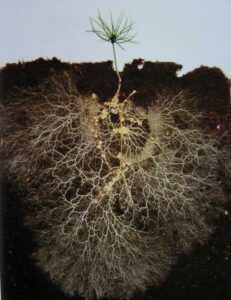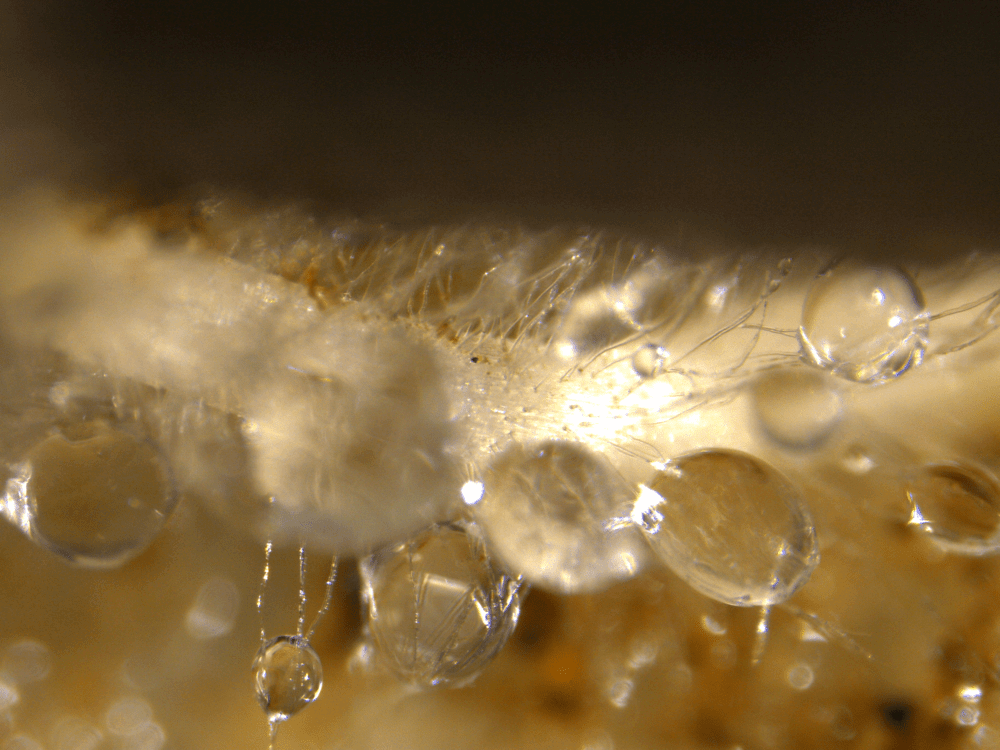The soil food web of microflora and microfauna constitutes an underground engine of fundamental significance to plant productivity. Mycorrhizal fungi play a key role in the functioning of this web of life, drawing down plant sugars derived from photosynthesis and providing much needed energy for the soil ecosystem. Mycorrhizal fungi also improve aggregate stability, enhance soil structure, protect plants from pests and diseases, build stable soil carbon, improve plant water-use efficiency, and increase the availability of important nutrients like phosphorus, sulfur, and nitrogen. Agricultural research tends to focus on conventionally managed crop and pasture lands where loss of diverse groundcover and/or intensive use of agrochemicals, have dramatically reduced the number and diversity of soil organisms, including beneficial microbes such as mycorrhizal fungi. As a result, the potential contribution of microbial symbionts to agricultural productivity has been greatly underestimated.
What Are Mycorrhizal Fungi and How Do They Work?

Mycorrhizal hyphae (white) colonizing the roots (yellow) of a pine seedling.
Arbuscular mycorrhizal fungi (AMF) are ‘obligate symbionts’, meaning they must form an association with living plants. They acquire their energy in a liquid form, as plant sugars, siphoned directly from actively growing roots. Mycorrhizal fungi cannot obtain energy in any other way. They have mechanisms enabling them to survive while host plants are dormant but cannot survive if host plants are removed for extended periods of time.
Arbuscular mycorrhizal fungi produce thin, hair-like threads of cytoplasm (hyphae) with a hyphal tip at each end. One tip enters a plant root and the other tip explores the soil matrix. Although the hyphae are small in diameter (usually less than 10 μm), the mycelial network can extend across many hectares. Mycorrhizal fungi have a fan-shaped architecture (see left), with long runner hyphae branching into networks of narrower and narrower absorbing hyphae. There can be over 100 hyphal tips at the end of each runner. These networks extend from the root system into the bulk soil, well beyond the zone occupied by the roots and root hairs. The absorptive area of mycorrhizal hyphae is approximately 10 times more efficient than that of root hairs and at least 100 times more efficient than roots.
An Amazing Symbiotic Relationship

The hyphae of mycorrhizal fungi connect plant roots to the soil. Organic nitrogen, phosphorus, sulfur, potassium, calcium, magnesium, iron, and essential trace elements such as zinc, manganese, and copper are transferred to plant hosts in exchange for carbon. Nutrient transfers are inhibited when high rates of inorganic nitrogen and/or water-soluble phosphorus are applied.
Plants colonized by mycorrhizal fungi can grow 10-20% faster than non-colonized plants, even though they are ‘giving away’ up to 40-50% of their liquid carbon to support and feed mycorrhizal networks. One of the reasons for this apparent paradox is that plants colonized by mycorrhizal fungi exhibit higher leaf chlorophyll contents and higher rates of photosynthesis than non-colonized plants. This enables them to fix greater quantities of carbon for transfer to fungal hyphae in the soil. In exchange for liquid carbon from their host, mycorrhizal fungi supply nutrients such as phosphorus, zinc, calcium, boron, copper and organic nitrogen. It’s an amazing symbiotic relationship. Mycorrhizal hyphae have a tubular vacuole system that allows bidirectional flow. Liquid organic carbon from the host plant and nutrients from the soil, can move rapidly and simultaneously in opposite directions within the same hyphal strand!
All groups of mycorrhizal fungi require a living host, but there’s more to it than just plants and fungi. A wide range of other soil microbes are also involved. For example, colonization of plant roots by mycorrhizal fungi is enhanced by the presence of certain ‘helper’ bacteria. There are also active colonies of bacteria surrounding the hyphal tips, producing enzymes that solubilize otherwise unavailable plant nutrients.
Mycorrhizal Fungi And Water
It is well known that mycorrhizal fungi access and transport nutrients in exchange for the carbon from the host plant. Less well known is that mycorrhizal fungi play an extremely important role in plant-water dynamics. The hyphal tips are hydrophilic (both the end in the plant and the end in the soil) enabling both water and nutrients to diffuse from one end to the other along a moisture gradient. Mycorrhizal fungi can supply moisture to plants by exploring micropores not accessible to plant roots. They can also improve hydraulic conductivity by bridging macropores in soils of low water-holding capacity (such as sands). Further, mycorrhizal fungi can increase drought resistance by effectively increasing the number and depth of plant roots.
Mycorrhizal Fungi And Soil Carbon
Glomalin, a long-lived glycoprotein (protein containing plant sugar) is a highly stable form of soil carbon that provides a protective coating for the hyphae of mycorrhizal fungi. Networks of fungal hyphae also provide an important first step for the polymerization of microbial necromass, ultimately leading to the formation of mineral-associated organic carbon (MAOC), previously known as humus. Organo-mineral complexes significantly improve soil structure, porosity, cation exchange capacity and plant growth. Both glomalin and mineral-associated carbon are of significance to the current debate on soil carbon transience, as these stable soil carbon fractions are not easily lost from soil during droughts or fires.
Land Management Impacts
Increasing the amount of stable carbon stored in agricultural soils via mycorrhizal fungi will require a redesign of many current land management techniques. Factors negatively impacting on mycorrhizal colonization include lack of continuous groundcover, single species crops and pastures, and application of herbicides, pesticides or fungicides. Mycorrhizal fungi are also inhibited by the application of large quantities of water-soluble nitrogen or phosphorus and by the presence of monocultures of non-mycorrhizal crops (such as canola). Although tillage is harmful, it has a less detrimental effect than previously assumed and recent studies have shown that the use of chemicals is more harmful than moderate soil disturbance. Biology friendly farming practices based on the presence of diverse living plant cover throughout the year and the use of biofertilizers enhance mycorrhizal abundance and diversity and are more beneficial for soil health than chemical farming systems based on intermittently bare soils and minimal soil disturbance. Due to their low abundance in conventionally managed agricultural landscapes, the important role of mycorrhizal fungi in nutrient acquisition, plant-water dynamics and soil building processes has been largely overlooked. The types of fungi that tend to survive in conventionally managed soils are non-mycorrhizal, that is, they utilize decaying organic matter such as crop stubbles, dead leaves or dead roots as their energy source rather than being directly connected to living plants. These non-mycorrhizal fungi have relatively small hyphal networks and are not able to transport water or nutrients to plants.

Plant root exudates stimulate the soil microbiome, particularly beneficial fungi.
Plant Diversity And Mycorrhizal Fungi
Higher densities of mycorrhizal hyphae are found in diverse perennial grasslands than in any other plant community. It has been estimated that the hyphae in the top 4 inches of four square yards of perennial grassland, if joined end to end, would stretch all the way around the equator of the earth. In diverse communities, plants join common mycelial networks called guilds. These networks connect plants and enable the exchange of nutrients and water. This may help explain why mixed plant communities often perform better than monocultures. In addition to the resilience conferred by mycorrhizal guilds, the benefits of permanent mycelial networks in terms of aggregate stability, porosity, improved soil water holding capacity, reduced erosivity and enhanced nutrient availability in soils are immense. The presence of a diversity of living plants year-round also buffers soil temperatures, enhances infiltration and markedly improves the habitat for soil biota. Significantly, it is the photosynthetic capacity of living plants (rather than the amount of dead plant material added to soil) that is the main driver for soil carbon accumulation and soil function. Management techniques that improve the diversity and vigor of groundcover, foster mycorrhizal colonization, increase glomalin production and enhance the formation of mineral-associated carbon, will contribute to long-term carbon storage, improved productivity and markedly increased resilience to climatic variability.
Article Written By: Dr. Christine Jones (see www.amazingcarbon.com for more information). This article was originally published in the September 2009 Issue of Evergreen Farming.
This article first appeared in the 9th Edition of Green Cover's Soil Health Resource Guide.
Also check out the 10th edition, our latest Soil Health Resource Guide, over 90 pages packed with scientific articles and fascinating stories from soil health experts, researchers, farmers, innovators, and more! All as our complimentary gift to you, a fellow soil health enthusiast!
